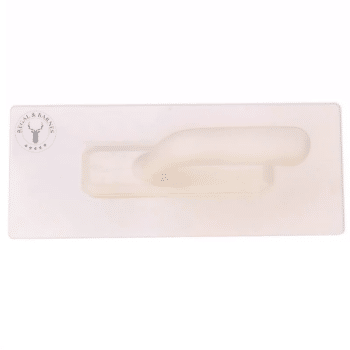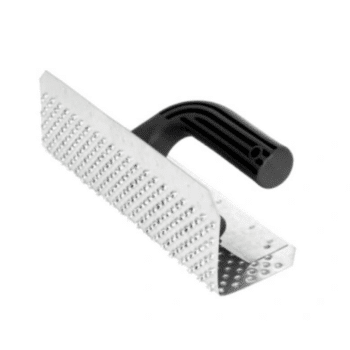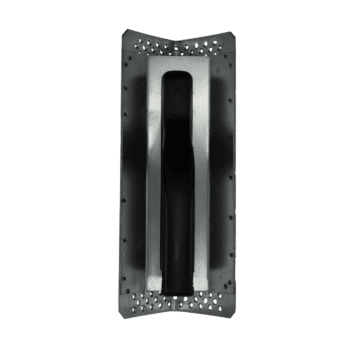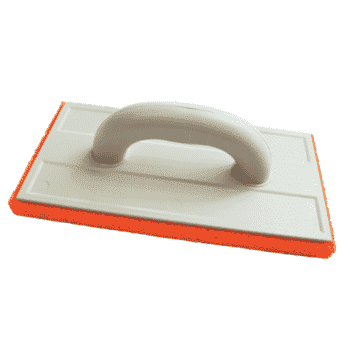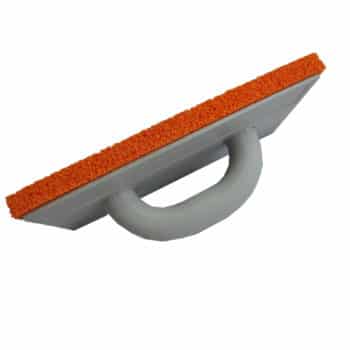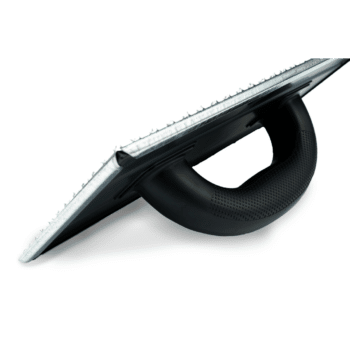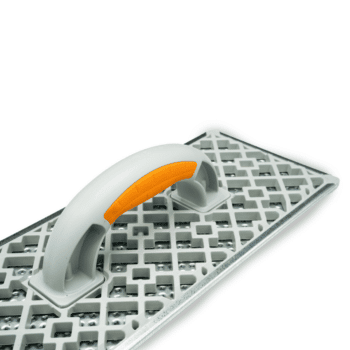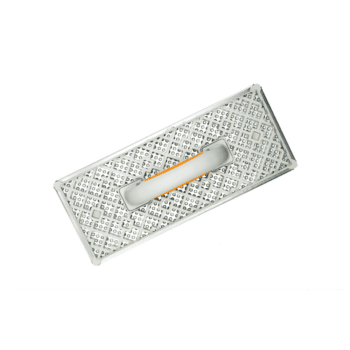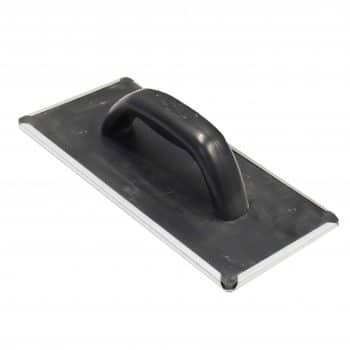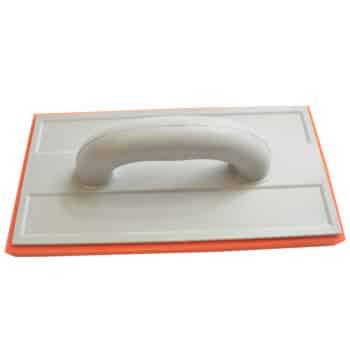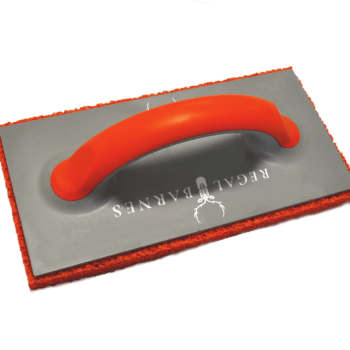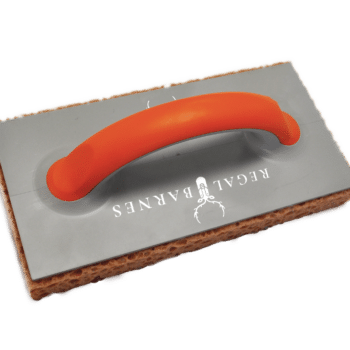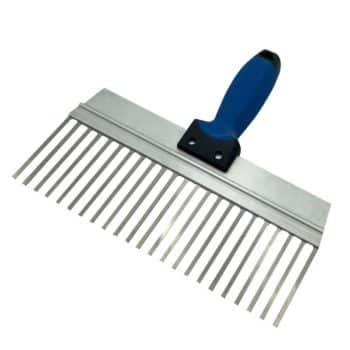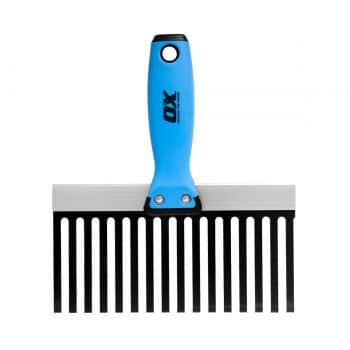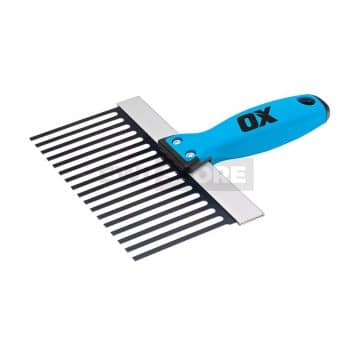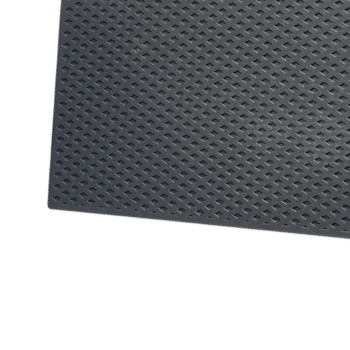4.8 out of 5 Stars on TrustPilot
Guide to Using Render Floats
Choosing the right float is crucial when achieving a flawless render or plaster finish. Whether you’re working with silicone render, monocouche, or plaster, each float has a specific purpose to help you achieve a smooth, even surface. In this guide, we’ll explore the most commonly used render floats, their applications, and how they can enhance the finish of your projects.
Plastic render float
Plastic render floats are specifically designed for silicone renders, making them a go-to tool for anyone working with this type of material. This float is particularly effective for rubbing up the render, ensuring an even and consistent surface texture. Here’s how it works:
- Rubbing Up: Once the silicone render has been applied and is beginning to dry, the plastic float is used to rub the surface in a circular motion. This action helps to smooth out the render and remove any irregularities, leaving a more uniform finish. Silicone renders often have various sized aggregates in them. The rubbing up of the render whilst still damp distributes the aggregates more evenly. As a result, the final finish is more aesthetically pleasing.
- Durability: Plastic render floats are lightweight yet durable, offering a comfortable grip that makes them ideal for extended use.
Sponge floats
A sponge float is an incredibly versatile tool. It is often used to smooth out plaster and remove imperfections like trowel lines. This float is designed with a sponge face that can be either fine or coarse, depending on the level of finish you’re looking to achieve.
- Fine vs Coarse Options: A fine sponge float is ideal for achieving a super-smooth finish, while a coarse sponge is better for texturing or working on rougher surfaces.
- Coarse Natural Rubber Sponge: One specific type of coarse float, the coarse natural rubber sponge, is especially effective for opening up the surface of gypsum plasters before the final finishing. It helps to remove trowel marks and air pockets, leaving the plaster smoother and ready for the final pass with a steel trowel.
- Multipurpose: Besides plaster, sponge floats are also excellent for removing grout from tiles, making them a valuable tool in any tradesperson’s kit.
Monocouche rasp/scratch float
If you’re working with monocouche render, you’ll want to use a monocouche scratch float. This tool typically comes with larger teeth designed for scraping back the monocouche once it’s partially set. It is perfect for creating texture or revealing detailing.
- Scraping Back: Once the monocouche has cured enough to hold its shape but remains workable, the scratch float is used to scrape the surface back to the desired depth. This technique can expose detailing like beads and other embedded elements.
- Texturing: The teeth on the float allow different textures to be created, giving you flexibility in finishing your render.
EPS rasp
An EPS rasp is commonly used on expanded polystyrene (EPS) insulation boards. Its main function is to remove the oily texture that can render adherence challenging. The rasp creates a mechanical key, ensuring the render properly bonds to the surface.
- Removing Oily Texture: EPS often has a smooth, slick surface, which isn’t ideal for applying render. The rasp effectively roughens the surface, improving the adhesion of your render.
- Mechanical Key: By creating tiny grooves or a roughened surface, the rasp helps the render adhere more securely, ensuring a longer-lasting finish.
What is a scarifier, and why is it needed for basecoat?
Scarifiers are tools designed for surface preparation, especially in plastering and rendering projects. Their primary function is to roughen or texture the surface, creating a better mechanical key for the next layer of material to bond to. They are particularly useful when working with hard surfaces that require enhanced adhesion.
- Surface Preparation: Scarifiers prepare surfaces before applying renders, plaster, or coatings. Creating a roughened texture improves the material’s bonding, helping prevent delamination or cracking.
- Use in Concrete and Masonry: They are often used on concrete, brick, and masonry surfaces to help break through hard surfaces or laitance (the weak layer on top of concrete). This roughened texture ensures that the next layer adheres properly, whether it’s render, plaster, or a finish coat.
- Creating a Key: Much like an EPS rasp, scarifiers are essential for creating a strong mechanical key, ensuring that layers of render or plaster firmly adhere to the surface beneath. They work by scraping or chipping the surface in a controlled way, creating grooves and rough spots for maximum adhesion.
-
Regal & Barnes – Plastic Float – 3mm
£8.39 Incl. VAT£6.99 Excl. VAT -
Angled Corner EPS Rasp (Plastic Handle)
£3.62 Incl. VAT£3.02 Excl. VAT£4.54 Incl. VAT£3.78 Excl. VAT -
Coarse Rubber Sponge Float 18mm
Rated 5.00 out of 5£6.43 Incl. VAT£5.36 Excl. VAT -
EPS Rasp (Plastic Handle) – 270mm x 130mm
£5.95 Incl. VAT£4.96 Excl. VAT£7.44 Incl. VAT£6.20 Excl. VAT -
EPS Rasp (Rubber Grip) – 375mm x 150mm
£9.79 Incl. VAT£8.16 Excl. VAT£12.24 Incl. VAT£10.20 Excl. VAT -
EPS Rasp (Rubber Handle) – 400mm x 180mm
£8.16 Incl. VAT£6.80 Excl. VAT£10.20 Incl. VAT£8.50 Excl. VAT -
Fine Rubber Sponge Float – 20mm
£6.58 Incl. VAT£5.48 Excl. VAT -
Regal & Barnes – Coarse Sponge Float 18mm
£9.59 Incl. VAT£7.99 Excl. VAT -
Regal & Barnes – Grout Sponge Float 30mm
£7.19 Incl. VAT£5.99 Excl. VAT -
Refina Scarifier
£17.34 Incl. VAT£14.45 Excl. VAT -
OX Scratch Render Scarifier
From £19.21 Incl. VATFrom £14.40 Incl. VATFrom £12.00 Excl. VAT -
Refina – ABS Plastic Diamond Faced Float – 270x180mm
£7.44 Incl. VAT£6.20 Excl. VAT
Facebook
Twitter
LinkedIn
Your cart
Trade Account Login

We use cookies on our website to give you the most relevant experience by remembering your preferences and repeat visits. By clicking “Accept All”, you consent to the use of ALL the cookies. However, you may visit "Cookie Settings" to provide personalised consent.
Manage consent
Privacy Overview
This website uses cookies to improve your experience while you navigate through the website. Out of these, the cookies that are categorized as necessary are stored on your browser as they are essential for the working of basic functionalities of the website. We also use third-party cookies that help us analyze and understand how you use this website. These cookies will be stored in your browser only with your consent. You also have the option to opt-out of these cookies. But opting out of some of these cookies may affect your browsing experience.
Necessary cookies are absolutely essential for the website to function properly. These cookies ensure basic functionalities and security features of the website, anonymously.
| Cookie | Duration | Description |
|---|---|---|
| __stripe_mid | 1 year | This cookie is set by Stripe payment gateway. This cookie is used to enable payment on the website without storing any patment information on a server. |
| __stripe_sid | 30 minutes | This cookie is set by Stripe payment gateway. This cookie is used to enable payment on the website without storing any patment information on a server. |
| _GRECAPTCHA | 5 months 27 days | This cookie is set by the Google recaptcha service to identify bots to protect the website against malicious spam attacks. |
| apbct_cookies_test | session | CleanTalk sets this cookie to prevent spam on comments and forms and act as a complete anti-spam solution and firewall for the site. |
| apbct_page_hits | session | CleanTalk sets this cookie to prevent spam on comments and forms and act as a complete anti-spam solution and firewall for the site. |
| apbct_prev_referer | session | Functional cookie placed by CleanTalk Spam Protect to store referring IDs and prevent unauthorized spam from being sent from the website. |
| apbct_site_landing_ts | session | CleanTalk sets this cookie to prevent spam on comments and forms and act as a complete anti-spam solution and firewall for the site. |
| apbct_site_referer | 3 days | This cookie is placed by CleanTalk Spam Protect to prevent spam and to store the referrer page address which led the user to the website. |
| apbct_timestamp | session | CleanTalk sets this cookie to prevent spam on comments and forms and act as a complete anti-spam solution and firewall for the site. |
| apbct_urls | 3 days | This cookie is placed by CleanTalk Spam Protect to prevent spam and to store the addresses (urls) visited on the website. |
| AWSALBCORS | 7 days | This cookie is managed by Amazon Web Services and is used for load balancing. |
| cookielawinfo-checkbox-advertisement | 1 year | Set by the GDPR Cookie Consent plugin, this cookie is used to record the user consent for the cookies in the "Advertisement" category . |
| cookielawinfo-checkbox-analytics | 11 months | This cookie is set by GDPR Cookie Consent plugin. The cookie is used to store the user consent for the cookies in the category "Analytics". |
| cookielawinfo-checkbox-functional | 11 months | The cookie is set by GDPR cookie consent to record the user consent for the cookies in the category "Functional". |
| cookielawinfo-checkbox-necessary | 11 months | This cookie is set by GDPR Cookie Consent plugin. The cookies is used to store the user consent for the cookies in the category "Necessary". |
| cookielawinfo-checkbox-others | 11 months | This cookie is set by GDPR Cookie Consent plugin. The cookie is used to store the user consent for the cookies in the category "Other. |
| cookielawinfo-checkbox-performance | 11 months | This cookie is set by GDPR Cookie Consent plugin. The cookie is used to store the user consent for the cookies in the category "Performance". |
| ct_checkjs | session | CleanTalk–Used to prevent spam on our comments and forms and acts as a complete anti-spam solution and firewall for this site. |
| ct_fkp_timestamp | session | CleanTalk sets this cookie to prevent spam on the site's comments/forms, and to act as a complete anti-spam solution and firewall for the site. |
| ct_pointer_data | session | CleanTalk sets this cookie to prevent spam on the site's comments/forms, and to act as a complete anti-spam solution and firewall for the site. |
| ct_ps_timestamp | session | CleanTalk sets this cookie to prevent spam on the site's comments/forms, and to act as a complete anti-spam solution and firewall for the site. |
| ct_sfw_pass_key | 1 month | CleanTalk sets this cookie to prevent spam on comments and forms and act as a complete anti-spam solution and firewall for the site. |
| ct_timezone | session | CleanTalk–Used to prevent spam on our comments and forms and acts as a complete anti-spam solution and firewall for this site. |
| elementor | never | This cookie is used by the website's WordPress theme. It allows the website owner to implement or change the website's content in real-time. |
| viewed_cookie_policy | 11 months | The cookie is set by the GDPR Cookie Consent plugin and is used to store whether or not user has consented to the use of cookies. It does not store any personal data. |
Functional cookies help to perform certain functionalities like sharing the content of the website on social media platforms, collect feedbacks, and other third-party features.
| Cookie | Duration | Description |
|---|---|---|
| __zlcmid | 1 year | This cookie is used by Zendesk live chat and is used to store the live chat ID. |
| bcookie | 2 years | LinkedIn sets this cookie from LinkedIn share buttons and ad tags to recognize browser ID. |
| bscookie | 2 years | LinkedIn sets this cookie to store performed actions on the website. |
| lang | session | LinkedIn sets this cookie to remember a user's language setting. |
| lidc | 1 day | LinkedIn sets the lidc cookie to facilitate data center selection. |
| UserMatchHistory | 1 month | LinkedIn sets this cookie for LinkedIn Ads ID syncing. |
Performance cookies are used to understand and analyze the key performance indexes of the website which helps in delivering a better user experience for the visitors.
| Cookie | Duration | Description |
|---|---|---|
| __utma | 2 years | This cookie is set by Google Analytics and is used to distinguish users and sessions. The cookie is created when the JavaScript library executes and there are no existing __utma cookies. The cookie is updated every time data is sent to Google Analytics. |
| __utmb | 30 minutes | Google Analytics sets this cookie, to determine new sessions/visits. __utmb cookie is created when the JavaScript library executes and there are no existing __utma cookies. It is updated every time data is sent to Google Analytics. |
| __utmc | session | The cookie is set by Google Analytics and is deleted when the user closes the browser. It is used to enable interoperability with urchin.js, which is an older version of Google Analytics and is used in conjunction with the __utmb cookie to determine new sessions/visits. |
| __utmt | 10 minutes | Google Analytics sets this cookie to inhibit request rate. |
| __utmv | 2 years | The __utmv cookie is set on the user's device, to enable Google Analytics to classify the visitor. |
| __utmz | 6 months | Google Analytics sets this cookie to store the traffic source or campaign by which the visitor reached the site. |
| sib_cuid | 6 months | Purechat uses this cookie to send data to purechat.com, to connect visitors to the reservation team and track visitors to stay on portal. |
| SRM_B | 1 year 24 days | Used by Microsoft Advertising as a unique ID for visitors. |
Analytical cookies are used to understand how visitors interact with the website. These cookies help provide information on metrics the number of visitors, bounce rate, traffic source, etc.
| Cookie | Duration | Description |
|---|---|---|
| _ga | 2 years | The _ga cookie, installed by Google Analytics, calculates visitor, session and campaign data and also keeps track of site usage for the site's analytics report. The cookie stores information anonymously and assigns a randomly generated number to recognize unique visitors. |
| _gat_gtag_UA_61069204_2 | 1 minute | Set by Google to distinguish users. |
| _gat_UA-61069204-2 | 1 minute | A variation of the _gat cookie set by Google Analytics and Google Tag Manager to allow website owners to track visitor behaviour and measure site performance. The pattern element in the name contains the unique identity number of the account or website it relates to. |
| _gcl_au | 3 months | Provided by Google Tag Manager to experiment advertisement efficiency of websites using their services. |
| _gid | 1 day | Installed by Google Analytics, _gid cookie stores information on how visitors use a website, while also creating an analytics report of the website's performance. Some of the data that are collected include the number of visitors, their source, and the pages they visit anonymously. |
| _uetsid | 1 day | This cookies are used to collect analytical information about how visitors use the website. This information is used to compile report and improve site. |
| CONSENT | 2 years | YouTube sets this cookie via embedded youtube-videos and registers anonymous statistical data. |
Advertisement cookies are used to provide visitors with relevant ads and marketing campaigns. These cookies track visitors across websites and collect information to provide customized ads.
| Cookie | Duration | Description |
|---|---|---|
| _fbp | 3 months | This cookie is set by Facebook to display advertisements when either on Facebook or on a digital platform powered by Facebook advertising, after visiting the website. |
| ANONCHK | 10 minutes | The ANONCHK cookie, set by Bing, is used to store a user's session ID and also verify the clicks from ads on the Bing search engine. The cookie helps in reporting and personalization as well. |
| fr | 3 months | Facebook sets this cookie to show relevant advertisements to users by tracking user behaviour across the web, on sites that have Facebook pixel or Facebook social plugin. |
| MUID | 1 year 24 days | Bing sets this cookie to recognize unique web browsers visiting Microsoft sites. This cookie is used for advertising, site analytics, and other operations. |
| NID | 6 months | NID cookie, set by Google, is used for advertising purposes; to limit the number of times the user sees an ad, to mute unwanted ads, and to measure the effectiveness of ads. |
| test_cookie | 15 minutes | The test_cookie is set by doubleclick.net and is used to determine if the user's browser supports cookies. |
| uuid | 6 months | MediaMath sets this cookie to avoid the same ads from being shown repeatedly and for relevant advertising. |
| VISITOR_INFO1_LIVE | 5 months 27 days | A cookie set by YouTube to measure bandwidth that determines whether the user gets the new or old player interface. |
| YSC | session | YSC cookie is set by Youtube and is used to track the views of embedded videos on Youtube pages. |
| yt-remote-connected-devices | never | YouTube sets this cookie to store the video preferences of the user using embedded YouTube video. |
| yt-remote-device-id | never | YouTube sets this cookie to store the video preferences of the user using embedded YouTube video. |
| yt.innertube::nextId | never | This cookie, set by YouTube, registers a unique ID to store data on what videos from YouTube the user has seen. |
| yt.innertube::requests | never | This cookie, set by YouTube, registers a unique ID to store data on what videos from YouTube the user has seen. |
Other uncategorized cookies are those that are being analyzed and have not been classified into a category as yet.
| Cookie | Duration | Description |
|---|---|---|
| _clck | 1 year | No description |
| _clsk | 1 day | No description |
| _uetvid | 1 year 24 days | No description available. |
| AnalyticsSyncHistory | 1 month | No description |
| apbct_pixel_url | session | No description |
| apbct_visible_fields_0 | session | No description |
| apbct_visible_fields_1 | session | No description |
| apbct_visible_fields_10 | session | No description |
| apbct_visible_fields_2 | session | No description |
| apbct_visible_fields_3 | session | No description |
| apbct_visible_fields_4 | session | No description |
| apbct_visible_fields_5 | session | No description |
| apbct_visible_fields_6 | session | No description |
| apbct_visible_fields_7 | session | No description |
| apbct_visible_fields_8 | session | No description |
| apbct_visible_fields_9 | session | No description |
| ct_checked_emails | session | No description |
| ct_has_scrolled | session | No description |
| ct_mouse_moved | session | No description |
| ct_screen_info | session | No description |
| ictf_master | never | No description available. |
| li_gc | 2 years | No description |
| m | 2 years | No description available. |
| SM | session | No description available. |
| testinfinitycookie | session | No description |
| woocommerce_show_tax | 7 days | No description available. |
| wp_woocommerce_session_c5ac76b408021294cb56bcc27eddf8a1 | 2 days | No description |


